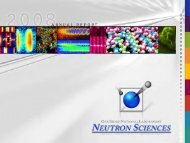ARCS materials - Spallation Neutron Source - Oak Ridge National ...
ARCS materials - Spallation Neutron Source - Oak Ridge National ...
ARCS materials - Spallation Neutron Source - Oak Ridge National ...
You also want an ePaper? Increase the reach of your titles
YUMPU automatically turns print PDFs into web optimized ePapers that Google loves.
8492 C P Adams et al<br />
population of magnons. The final term is the appropriate susceptibility for a damped simple<br />
harmonic oscillator (DSHO) with linewidth Ɣ and free-mode energy ¯hωQ. This cross-section<br />
correctly approaches δ-functions in the Ɣ ≪ ¯hωQ limit.<br />
The simulation, using equation (2) and the previously mentioned SJ-values, successfully<br />
describes the spin-wave intensity and dispersion through several magnetic Brillouin zones.<br />
Subsequent fixing of the proportionality in equation (2) gives the results for Ɣ shown in<br />
figure 4. This confirms that the peak broadening in figure 2 is due to increasing Ɣ rather than the<br />
coarsening resolution at higher Ei. The damping increases rapidly beyond ¯hωQ = 220 meV,<br />
wiping out the well defined magnon peaks; uncertainties in peak position and linewidth increase<br />
accordingly. Such large values of Ɣ for T ≪ TN are not expected on the basis of local<br />
models where magnon–magnon scattering dominates. Hence, this damping is anomalous and<br />
must be due to itinerant electrons, a conclusion previously reached in studies of several FM<br />
systems [15–17]. In fact, the itinerant effects eventually predominate over the local behaviour<br />
and the spin waves merge into a continuum of excitations (Ɣ ∼ E). Calculation of Ɣ in<br />
itinerant systems often requires detailed knowledge of the electronic band structure [23] but<br />
in FeGe2 the reduced dimensionality and the lack of electron correlations may simplify such<br />
a prediction, providing important insight into several classes of itinerant magnetic systems.<br />
One result that appears to be preserved from a local-moment model is the quadratic<br />
variation of Ɣ with E predicted by the hydrodynamic model [24]. A range of appropriate<br />
quadratic parametrizations is shown in figure 4 with the best description being given for<br />
Ɣ = 2.7 × 10 −3 E 2 (meV units). The reciprocal of the prefactor is 370 ± 80 meV, comparable<br />
to 4SJFM = 272 meV, half of the zone boundary energy. The hydrodynamic model includes<br />
SJ in a similar way but also includes a T -dependent term, (T /TN) 3 , which would eliminate<br />
low-T damping. This is clearly in disagreement with figure 4.<br />
Figure 4. The magnon linewidth Ɣ versus E. The solid and dashed lines represent the function and<br />
the uncertainty given in the figure. Note the rapid increase of Ɣ beyond 220 meV and the gradual<br />
merging into a continuum of excitations.

















